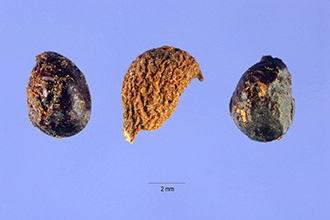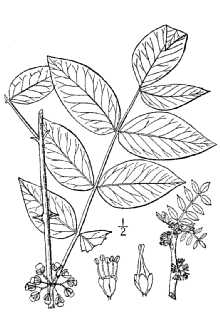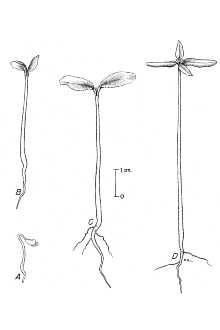Common Pricklyash
Scientific Name: Zanthoxylum americanum Mill.

| General Information | |
|---|---|
| Usda Symbol | ZAAM |
| Group | Dicot |
| Life Cycle | Perennial |
| Growth Habits | ShrubTree, |
| Native Locations | ZAAM |
Plant Guide
Alternate Names
Northern prickly ash, toothache tree; this genus is incorrectly spelled Xanthoxylum in much of the literature.
Uses
Ethnobotanic: The Alabama, Cherokee, Chippewa, Comanche, Creek, Delaware, Iroquois, Oklahoma, Menominee, Meskwaki, Ojibwa, Pawnee, and Potawatomi were among the Native American tribes that used common pricklyash for many, mostly medicinal purposes. An infusion of the bark was used as a wash to treat itching skin and to treat swollen joints. Infusions of the bark were taken internally for back pain, cramps, pulmonary problems, to treat fevers, and as a cold and cough remedy. Infusions, made from the crushed roots, were also used to treat fevers. A poultice made from the inner bark was used to treated rheumatism and sharp pains. Placing the inner bark in the throat treated sore throats. The bark was boiled into a decoction that was taken to induce miscarriages. The plant was used to treat pain after childbirth. Bark infusions were taken to treat worms in adults. The bark of the roots was used to treat colic, rheumatism, and gonorrhea. An ointment, made my mixing the plant with bear grease, was applied to ulcers and sores. Infusions of the berries were used to spray on the chest and throat to treat bronchial diseases, to wash sores, and to flavor medicines. The bark and the berries were used to treat hemorrhages, to make cough syrup, as an expectorant, and to treat tuberculosis. Children who were weak were washed with a decoction of the bark to make their legs and feet strong. The bark was used in different forms to alleviate toothaches. Smoking the bark treated toothache. Bark, either beaten or powdered was packed in and around an aching tooth. Pieces of the bark were chewed to help breakup a tooth that was to be remove. The plant was an ingredient in compounds that were used for kidney trouble, to strengthen convalescing patients, and to induce vomiting. An infusion of the bark was, at least once, placed on a dog’s nose to improve its scenting capabilities during hunting. The fruits were administered as diuretics to horses. Young men of the Omaha tribe used a perfume made from the fruits. The plant is probably still used today for various purposes by various Native American tribes. ©John Kasmer Northeastern Illinois University Wildlife: The fruits are eaten by a variety of birds and small mammals including bobwhite quails, vireos, pheasants, cottontails, and eastern chipmunks. Bees are attracted to the flowers. Giant swallowtail butterflies lay their eggs on the plants leaves.
Status
Please consult the PLANTS Web site and your State Department of Natural Resources for this plant’s current status (e.g. threatened or endangered species, state noxious status, and wetland indicator values).
Description
General: Rue Family (Rutaceae). It is an aromatic, native, perennial tree or shrub that can grow from 1 to 8 meters tall. The branches are dark brown and armed with 8 to 13 mm-long prickles. When broken, the twigs have a strong odor reminiscent of crushed lemon peel. The leaf buds (1mm long) are red and woolly. The leaves (1 to 30 cm long) are composed of 5 to 11 ovate, pinnately arranged leaflets (4 to 8 cm long). The dark green and lustrous leaves are dotted with translucent glands. The lower portion of the leaf is a lighter pubescent green beneath. The greenish-yellow flowers (3 to 3.5 mm wide) appear in the spring before the leaves. The small fruits are capsules (0.5 to 0.6 cm). Each fruit contains one seed. The fruit ripens in late summer, turning from green to reddish brown. When the seeds mature, they hang exposed from the split capsules. Distribution: For current distribution, please consult the Plant Profile page for this species on the PLANTS Web site. Habitat: This plant occurs along riverbanks and in moist ravines, thickets, and woods. It is also found in somewhat drier areas such as upland rocky hillsides, bluffs, and open woods.
Establishment
Common pricklyash is a very hearty tree or small shrub that does well in poor soils. Although easily grown, the plants are not generally used for landscape purposes as ornamentals. Because of the plants small yet sharp thorns and suckering habit, they can make an efficient barrier planting. The plants do well in partial shade to full sun. Seeds, suckers, and root cuttings may propagate pricklyash. The seeds may be gathered from the plants when the capsules are open. Unopened capsules will open upon drying. The seeds will require scarification to germinate, unless they are sown in the fall immediately after collecting them.
Pests and Potential Problems
Common pricklyash has no serious insect or disease problems. Cultivars, Improved and Selected Materials (and area of origin) These plant materials are not readily available from commercial sources. Contact your local Natural Resources Conservation Service (formerly Soil Conservation Service) office for more information. Look in the phone book under ”United States Government.” The Natural Resources
Conservation
Service will be listed under the subheading “Department of Agriculture.”
References
Bailey, L.H. & E.Z. Bailey 1976. Hortus Third: A concise dictionary of plants cultivated in the United States and Canada. Simon and Schuster Macmillan Co., New York, New York. 1290 pp. Dirr, M.A. 1998. Manual of woody landscape plants. Fifth Edition. Stipes Publishing, Champaign, Illinois. 1187 pp. Dutton, B.E. 1996. Zanthoxylum americanum Mill. [Online]. Available: http://www.bbg.org/research/nymf/encyclopedia/rut/zan0010.htm. (25 June 2001). Flint, H.L. 1997. Landscape plants for Eastern North America. Second Edition. John Wiley and Sons, New York, New York. 842 pp. Hamel, P.B. & M.U. Chiltoskey 1975. Cherokee plants and their uses: A 400-year history. Herald Publishing Company, Sylva, North Carolina. 65 pp. Herrick, J.W. 1995. Iroquois medical botany. Syracuse University Press, Syracuse, New York. 278 pp. Kasmer, J. 1998. Biology 498: Zanthoxylum americanum. Northeastern Illinois University, Chicago, IL. Accessed: 27sep01. <www.neiu.edu/~jkasmer/Biol498/species.htm>. Missouri Botanical Garden 2000. Kemper Center for Home Gardening: Zanthoxylum americanum. [Online]. Available: http://www.mobot.org/hort/plantfinder/Code/M/M90. htm. (25 June 2001). Moerman, D.E. 1998. Native American ethnobotany. Timber Press, Portland, Oregon. 927 pp. Moerman, D.E. 1999. Native American
Ethnobotany
Database: Foods, drugs, dyes and fibers of native North American Peoples, The University of Michigan-Dearborn, [Online], Available: http://www,umd,umich,edu/cgi-bin/herb(25 June 2001), Oklahoma Biological Society Survey 1999, Zanthoxylum americanum P, Mill, [Online], Available: http://www,biosurvey,ou,edu/shrub/zante-ame,htm, (25 June 2001), Sayre, L,E, 1925, The botanical features of the new United States pharmacopoeia, American Journal of Pharmacology April 1925: 185-271, Small, J,K, 1933, Manual of Southeastern flora, University of North Carolina Press, Chapel Hill, North Carolina, 1554 pp, Swanson, R,E, 1994, A field guide to the trees and shrubs of the Southern Appalachians, John Hopkins University Press, Baltimore, Maryland, 399 pp, Use soil moisture sensors to measure the soil moisture of Common Pricklyash., Swanton, J,R, 2000, Creek religion and medicine, University of Nebraska Press, Lincoln, Nebraska, 684 pp,


